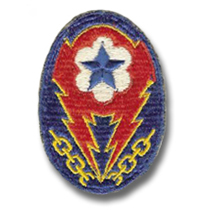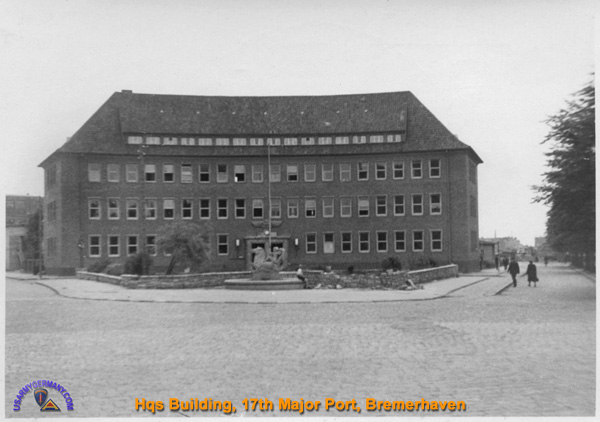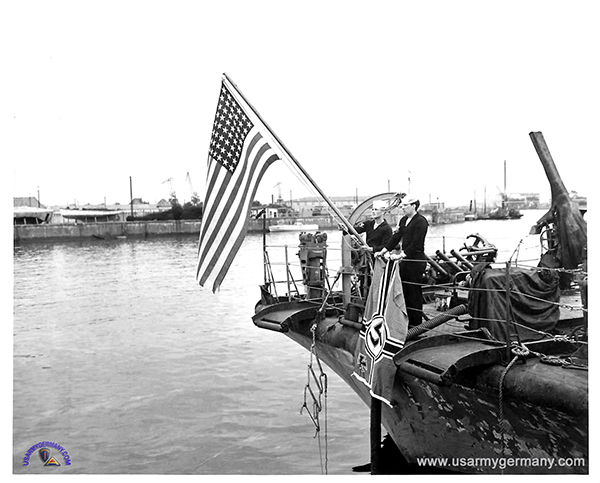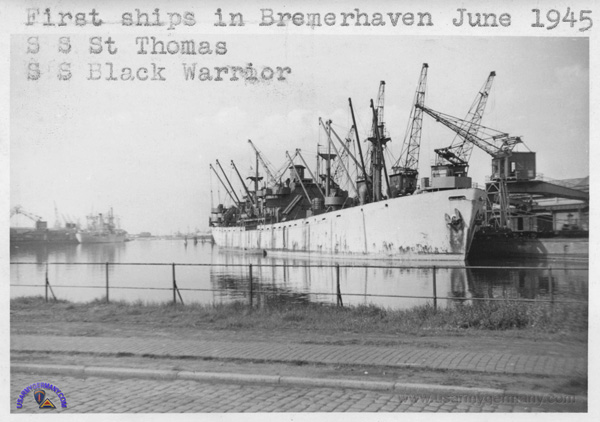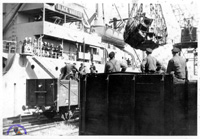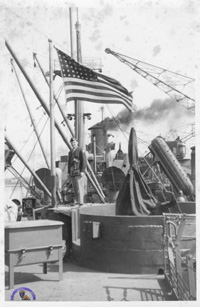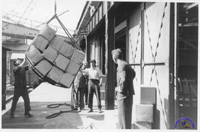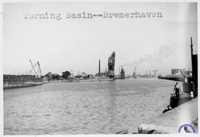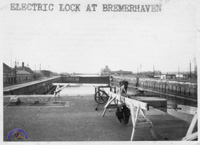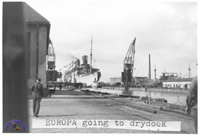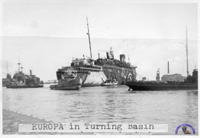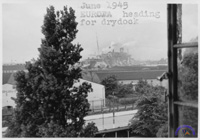| If you do
NOT see the Table of Contents frame to the left of this page, then
Click here to open 'USArmyGermany' frameset |
|||||||||
|
17th Major Port |
|||||||||
|
|
|||||||||
|
|||||||||
|
|
|||||||||
| 17th Major Port | |||||||||
 A Victory ship unloads supplies at the port of Bremerhaven, July 1945 |
|||||||||
| 1945 | |||||||||
| What is a "Major Port"? | |||||||||
| (Source: The Transportation Corps: Operations Overseas, United States Army in World War II series) A new Table of Organization and Equipment for a major port headquarters (oversea), approved in November 1943, was a result of experiences gained in the early years of the war and the need to meet local requirements. It called for a reduction in the normal strength from 579 to 519 officers and men. The resultant reorganization was effected at the several ports in the United Kingdom early in 1944 (including the 17th Major Port). Headed by a port commander, who might have the rank of brigadier general, the new port headquarters was designed to function with two port directors: one for services (including administration and the several supply services); and the other for operations (including a transportation division and a water division). Port battalions, Quartermaster truck companies, harbor craft units, ship maintenance and repair companies, and other service and operating units were to be attached as required by local conditions and the amount of traffic to be handled. |
|||||||||
| In reviewing the historical manuscript "Transportation" from the OCCUPATION FORCES series, I believe that the 17th Major Port in the Fall of of 1945 included the 487th Port Bn, three Port companies and the 330th Harbor Craft Co. | |||||||||
| (Source: Volume I, The First Year, OCCUPATION FORCES series) | |||||||||
| On May 24 1945, the Bremen Enclave, including the ports of Bremen and Bremerhaven, was occupied by US forces. | |||||||||
| Caption on Signal Corps photo: American sailors now control the sub pens and docks of Bremen and Bremerhaven, two major German ports on the Weser River. The Stars and Stripes replace the Nazi Swastica over a German destroyer, captured when the US Navy moved into Bremerhaven. Hoisting the colors are D.R. Farce, Coxswain (left) of Orange, Texas, and J.J. Cotter, Soundman, of 42 Goldsmith St., Jamaica Plain, Mass. Both men are attached to the US Navy's advance base set up in Bremerhaven to supply American occupational forces. | |||||||||
| (Source: Volume III, The First Year, OCCUPATION FORCES series) | |||||||||
| The shift toward use of the ports of Bremen and Bremerhaven for receipt of supplies and handling of supplies through a depot system completely within Germany began the end of September. Bremen had been so badly damaged that the complete opening of the port area was delayed until September 11. The conditions at Bremerhaven were not so bad, and that port was able to open on June 22. When the United States forces started using the port of Bremerhaven in June 1945, 22,000 tons of cargo were discharged at the port. By July 162,000 tons, or approximately 20 percent of the military cargo unloaded at Continental ports, came through this port. The peak was reached in April 1946 with 181,000 tons. Thereafter the decrease in Theater strength was reflected in reduced shipping. The total declined in June 1946 to 58,000 tons. By the end of June 1946, all personnel and cargo to and from, occupied territory was being handled through Bremen-Bremerhaven.. Other ports on the continent were closed and returned to the donor nations as the line of communications was shifted to Germny and Bremen and Bremerhaven were able to handle the incoming and outgoing cargo. The construction program adopted at Bremerhaven for the period of January to June 1946 called for 423,000 man-hours of labor and 1,210 long tons of supplies, but by June 1946 only 66,710 man-hours had been completed. |
|||||||||
| CORRECTIONS (Source: Email from Georg Krutwig, Germany) Some of the above pictures have a wrong description. Under "Operations 17th Major Port" No. 2 there is a picture with LT Col Kranz and Capt Kline. This photo actually shows the Ueberseehafen in Bremen, not Bremerhaven. Also, the pictures No. 6 and No. 7 show the Kaiserhafen 1 in Bremerhaven. This is not a turning basin. This harbor basin is for docking on both sides, like the basins Kaiserhafen 2 and 3. Otherwise, this website is very interesting. especially the photos were important for me, because the history of Bremerhaven is one of my hobbies. Thank you for publishing. |
|||||||||
| The German transatlantic line, the S/S Europa, was seized by the Americans in the port of Bremerhaven in May 1945. The Maintenance and Repair section of the 17th Major Port converted the Europa to a troopship and she was used as a US Navy troop transport until 1946, when the Europa was handed over to France in compensation for the loss of the S.S. Normandie during the Second World War. | |||||||||
|
|||||||||
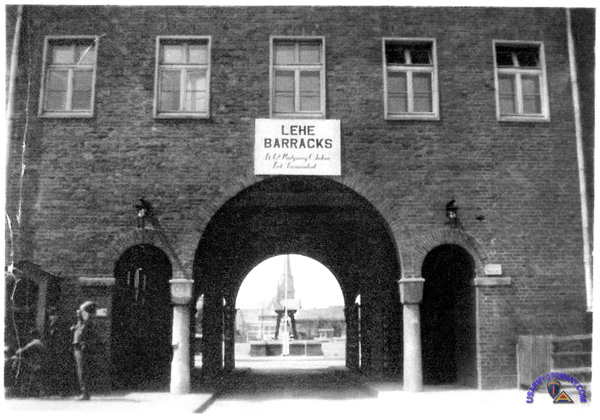 Lehe Barracks, Bremerhaven, 1945 |
|||||||||
| 1946 | |||||||||
| (Source: Volume I, The First Year, OCCUPATION FORCES series) | |||||||||
| On April 15 1946, the Bremen Port Command was discontinued and its primary subordinate command, the 17th Major Port, became the main administrative headquarters for the Bremen-Bremerhaven area. | |||||||||
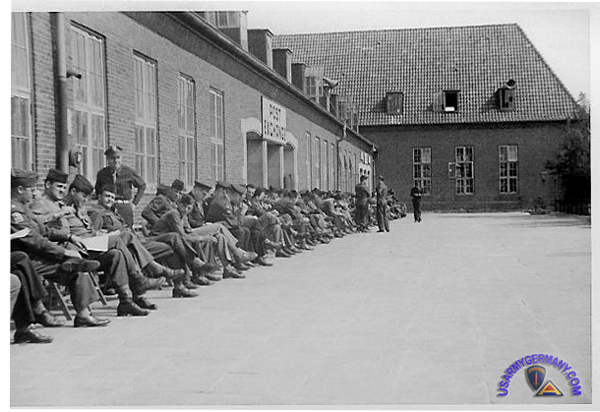 Redeploying Army and Air Force personnel read the Stars & Stripes and magazines in front of the PX as they wait for their ship back to the US, 1946 (Bill Parrish) |
|||||||||
| (Source: The Second Year, Vol V., OCCUPATION FORCES series) | |||||||||
| 1. The 17th Major Port and Continental Base Section Sub.Sector No. 4. With the deactivation of the Bremen Port Command on 15 April 1946, the headquarters of the 17th Major Port, commanded by Col. Edward M. Conner, Jr., became the main administrative headquarters in the Bremen Enclave. The Continental Base Section Sub-Sector No. 4 was activated at this time as a coordinating and inspecting agency of the commanding general of the Continental Base Section, who was charged with area responsibility in the Bremen Enclave. For administration of community affairs the Enclave was divided into two military communities, the commanding officer of the 17th Major Port being responsible for the Bremerhaven Area and the commanding officer of Sub-Sector No. 4 for the remainder of the area. The Sub-Sector commander was also the commander of all tactical troops in the Enclave and directly responsible to the commanding general of Continental Base Section for security. Divisional commanders of the 17th Major Port were: Deputy Commander, Col. Paul J. Matte; Director of Administration, Col. Alfred J. de Lorimier; Director of Operations, Col. Herschel D. Baker; and Director of Port Services, Col. O. P. Bragan. Dependents began arriving in April 1946, and were transferred directly from ship to special trains destined for Berlin, Frankfurt, Munich and Vienna. In June 1946 the Port became responsible for processing all female civilians returning to the Zone of the Interior and the Dependents' Hotel in Bremerhaven became headquarters for redeploying dependents, 2. The Bremerhaven Military Community. 3. Military Government. |
|||||||||
| 1947 | |||||||||
| (Source: Information obtained by Robert L. Bauer through the National Archives) | |||||||||
| Hq. & Hq. Company, 17th Transportation Corps Major Port is redesignated Hq. & Hq. Company, 17th Transportation Major Port effective as of 22 April 1947. Unit will be reorganized at the earliest practicable date by the Commander in Chief, European Command by deleting medical personnel, in accordance with Table of Organization & Equipment 55-110-1 (20 November 1943) w/3 Changes, with an authorized strength of 106 Officers, 1 Warrant Officer, 394 Enlisted Men; reference is made to radio WAR 96690 dated 22 April 1947 - per AGAO-1 322 (22 Apr 1947) WDGOT-M dated 9 May 1947. | |||||||||
| (Source: The American Military Occupation of Germany, 1945 - 1953) | |||||||||
On May 15, 1947, the Continental Base Section was discontinued. Its major operation, the Bremerhaven Port of Embarkation (BPE Page), which had been created on March 15, 1947, was made a major subordinate command of EUCOM. |
|||||||||
|
|
|||||||||
| Port of Bremen | |||||||||
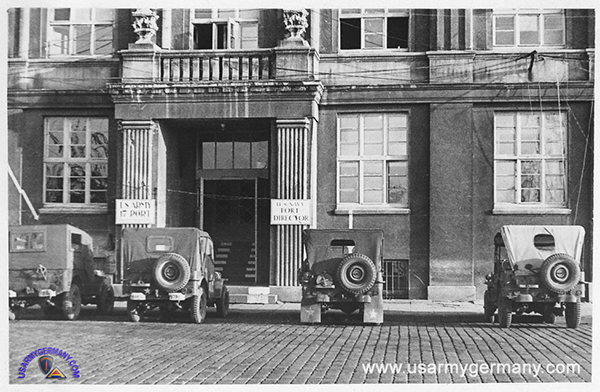 Port operations headquarters at the Übersee Docks, Bremen, 1945 |
|||||||||
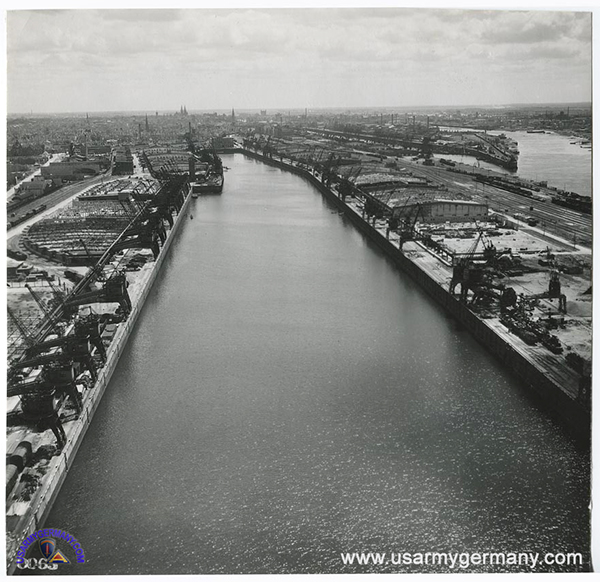 Photo of the Übersee Docks taken by an Army Air Corps reconnaissance plane in 1945 |
|||||||||
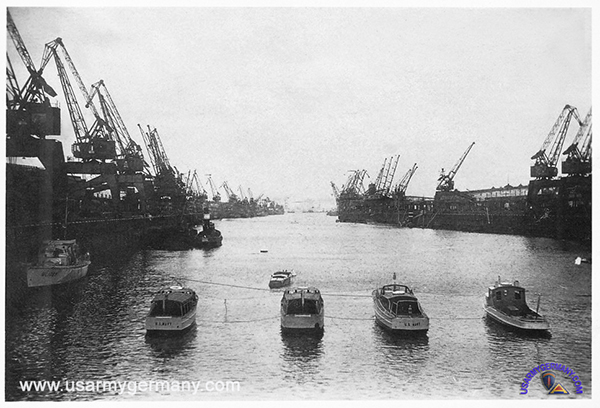 View of the Übersee Docks from the Operations building, 1945. Vessels in the foreground belong to a small fleet of Navy watercraft assigned to port operations at Bremen. |
|||||||||
| Related Links | |||||||||
